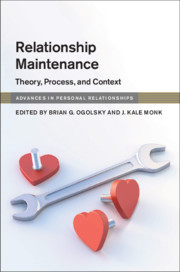Book contents
- Relationship Maintenance
- Advances in Personal Relationships
- Relationship Maintenance
- Copyright page
- Contents
- Tables
- Figures
- Contributors
- Part I Introduction
- Part II Theories of Relationship Maintenance
- Part III Processes of Relationship Maintenance
- 7 Communication and Relationship Maintenance
- 8 Attributions, Forgiveness, and Gratitude as Relationship Maintenance Processes
- 9 Social Networks and Relationship Maintenance
- 10 Dyadic Coping as Relationship Maintenance
- 11 Conflict Management and Problem Solving as Relationship Maintenance
- 12 Sex as Relationship Maintenance
- 13 Accuracy and Bias in Relationship Maintenance
- Part IV The Social Context of Relationship Maintenance
- Part V Conclusion
- Index
- References
7 - Communication and Relationship Maintenance
from Part III - Processes of Relationship Maintenance
Published online by Cambridge University Press: 02 December 2019
- Relationship Maintenance
- Advances in Personal Relationships
- Relationship Maintenance
- Copyright page
- Contents
- Tables
- Figures
- Contributors
- Part I Introduction
- Part II Theories of Relationship Maintenance
- Part III Processes of Relationship Maintenance
- 7 Communication and Relationship Maintenance
- 8 Attributions, Forgiveness, and Gratitude as Relationship Maintenance Processes
- 9 Social Networks and Relationship Maintenance
- 10 Dyadic Coping as Relationship Maintenance
- 11 Conflict Management and Problem Solving as Relationship Maintenance
- 12 Sex as Relationship Maintenance
- 13 Accuracy and Bias in Relationship Maintenance
- Part IV The Social Context of Relationship Maintenance
- Part V Conclusion
- Index
- References
Summary
This chapter reviews scholarship on communication and relational maintenance and introduces a new conceptualization of relational maintenance: maintenance as growth. Communication plays a unique role in the maintenance of relationships, as it serves both as a maintenance mechanism and as the means through which other maintenance mechanisms are made manifest. In order to limit the scope, the focus is upon romantic relationships. A synopsis of the history of the study of communication and relational maintenance is offered by reviewing typologies, motivations, antecedents, and the complex connections among maintenance behaviors and relational features. The four most often invoked definitions of maintenance are reviewed, and a fifth new definition of maintenance is proposed in order to extend our conceptualizations of relational maintenance. This fifth, heretofore unarticulated (at least explicitly), is one wherein maintenance is seen as the process of keeping a relationship growing. Maintenance is defined as the state and process of growth or continuous positive change. How we communicate maintenance in accordance with definitions of relational maintenance is considered. Areas for further research are put forward, including attention to maintenance as a multiplex of behaviors as well as the valence, context, timing, and perceived intent of maintenance behaviors.
Keywords
- Type
- Chapter
- Information
- Relationship MaintenanceTheory, Process, and Context, pp. 109 - 133Publisher: Cambridge University PressPrint publication year: 2019
References
- 2
- Cited by



